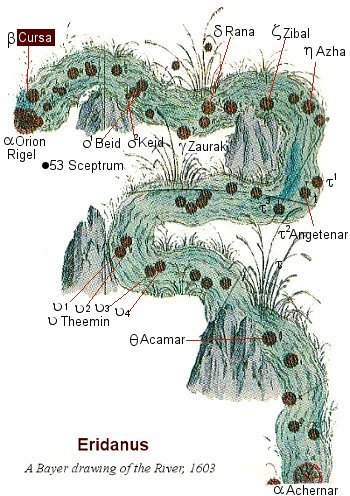| Fixed star: CURSA | |
| Constellation: Beta (β) Eridanus | |
| Longitude 1900: 13GEM53 | Longitude 2000: 15GEM17 |
| Declination 1900: -05.13′ | Declination 2000: -05.05′ |
| Right ascension: 05h 07m | Latitude: -27.51′ |
| Spectral class: A3 | Magnitude: 2.9 |
The history of the star: Cursa
from p.218 of Star Names, Richard Hinckley Allen, 1889.
[A scanned copy can be viewed on this webpage

Cursa, 3° to the northwest of Rigel in Orion, is the principal star in this constellation seen from the latitude of New York City.
The word is from Al Kursiyy al Jauzah, the Chair, or Footstool, of the Central One, i.e. Orion, formed by beta (β this star Cursa), lambda (λ), and psi (ψ) Eridanus with Orion, and regarded as the support of his left foot; but in the earlier astronomy of the nomads it was one of Al Udha al Na’am, the Ostrich’s Nest, that some extended to omicron (οBeid) and omicron (οKeid).
The Century Cyclopedia gives Dhalim as an alternative title, undoubtedly from Al Thalim, the Ostrich; but, although used for beta (β this star Cursa) by several writers, this better belongs to theta (θ Acamar).
The Chinese called beta (β this star Cursa) Yuh Tsing, the Golden Well.
Star Names, Their Lore and Meaning, Richard Hinckley Allen, 1889].
The astrological influences of the constellation Eridanus
Legend: Eridanus represents the river Padus or Po into which Phaeton fell when slain by Jupiter for having set the world on fire by misguiding the chariot of his father Phoebus. [Robson, p.44.]
Influences: According to Ptolemy all the stars with the exception of Achernar are like Saturn. Eridanus gives a love of knowledge and science, much travel and many changes, a position of authority, but danger of accidents especially at sea and of drowning. [Robson, p.44.]
References:
Fixed Stars and Constellations in Astrology, Vivian E. Robson, 1923].